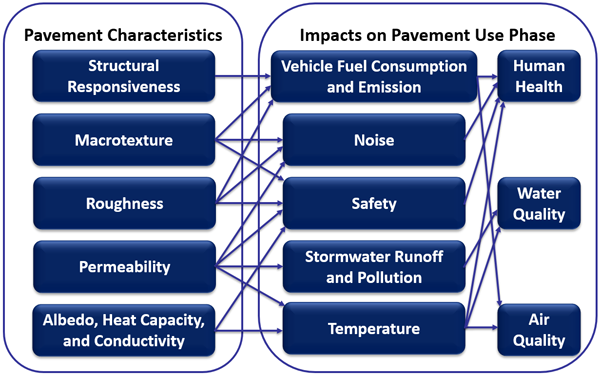Pavement Use-Phase Considerations
The environmental and social impacts of pavements in the use phase include the influence of pavement on vehicle operations and the interaction between the pavement, the environment, and humans. Figure 1 indicates various pavement characteristics and their potential impacts on the use phase.

Figure 1. Pavement characteristics and influences on use-phase objectives.
As shown in figure 1, pavement roughness (or smoothness), structural responsiveness (related to stiffness, damping, and deflection under traffic), and macrotexture have all been identified as affecting vehicle fuel consumption, and as a result can have significant economic and ecological implications on vehicle operating costs and emissions. In addition, those same factors may contribute to freight damage while impacting the safety and comfort of road users. Moreover, pavement surface texture, permeability, and other pavement surface characteristics can impact the noise generated by the tire-pavement interaction, which can affect humans both in vehicles and within the acoustical range of the vehicles operating on the pavement; they also have important safety considerations with regards to surface friction, hydroplaning, and wet-weather crashes.
The permeability of the pavement system can influence stormwater runoff and surface friction, and potentially the costs associated with stormwater treatment. Pavements that are partially or fully permeable can flatten flow-duration curves to reduce the peak flow rate and can also affect pollution flow into receiving water bodies and their water temperatures.
The albedo (reflectivity), heat capacity, and thermal conductivity of the pavement all affect the absorption of energy from the sun and the emission of reflected and thermal energy from the pavement, which can potentially affect energy consumption of building cooling and lighting systems, vehicle cooling systems, air quality, and human health (depending on a number of factors). The global balance of energy (radiative forcing) is also influenced by surface albedo. For some applications, the luminance of the pavement may also have an effect on the energy needed for roadway lighting for nighttime safety, visibility of objects, and the ability for drivers to see pavement markings and obstacles.
Some of the decisions regarding use-phase effects that can affect sustainability are made at the network level and can be implemented through effective pavement management systems (PMS), while others can only be implemented at the project level through design and construction decisions. There are trade-offs that may be considered within many of these decisions, including important safety issues. Many of these trade-offs are sensitive to project context, particularly traffic levels and climate. Project context also often has a large influence on the relative importance of environmental impacts of different phases of the pavement life cycle; for example, use-phase impacts on routes with heavy traffic are often much greater than material production and construction phase impacts, while the opposite may be true for low-traffic routes.
It must be recognized that many of these use-phase effects are not currently well quantified. A summary of the major use-phase issues include:
- Trade-offs between negative effects of material production and construction activities during maintenance and rehabilitation versus use-phase benefits.
- Consideration of smoothness over the entire life cycle and achieving the highest level of smoothness possible during initial construction and subsequent maintenance and rehabilitation activities.
- Consideration of pavement structural responsiveness to loading.
- Preserving smoothness in locations with utilities (avoiding utility cuts when possible)
See Chapter 6 (.pdf) of the Reference Document for more details.

